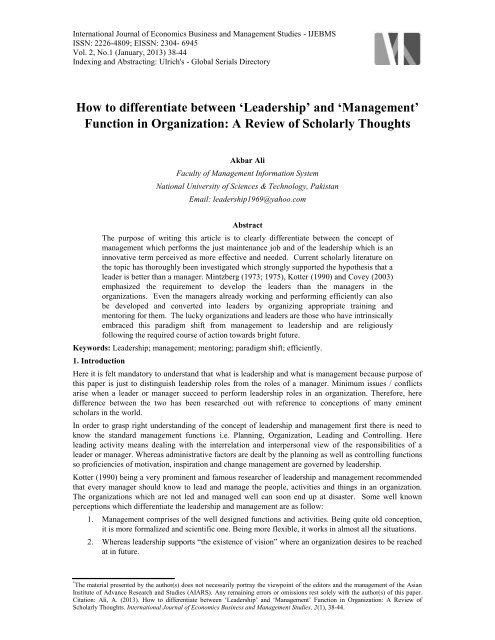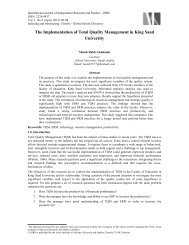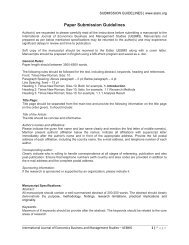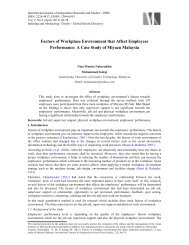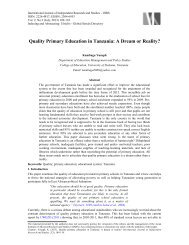'Leadership' and 'Management' Function in Organization - Aiars.org
'Leadership' and 'Management' Function in Organization - Aiars.org
'Leadership' and 'Management' Function in Organization - Aiars.org
Create successful ePaper yourself
Turn your PDF publications into a flip-book with our unique Google optimized e-Paper software.
International Journal of Economics Bus<strong>in</strong>ess <strong>and</strong> Management Studies - IJEBMSISSN: 2226-4809; EISSN: 2304- 6945Vol. 2, No.1 (January, 2013) 38-44Index<strong>in</strong>g <strong>and</strong> Abstract<strong>in</strong>g: Ulrich's - Global Serials DirectoryHow to differentiate between ‘Leadership’ <strong>and</strong> ‘Management’<strong>Function</strong> <strong>in</strong> <strong>Organization</strong>: A Review of Scholarly ThoughtsAkbar AliFaculty of Management Information SystemNational University of Sciences & Technology, PakistanEmail: leadership1969@yahoo.comAbstractThe purpose of writ<strong>in</strong>g this article is to clearly differentiate between the concept ofmanagement which performs the just ma<strong>in</strong>tenance job <strong>and</strong> of the leadership which is an<strong>in</strong>novative term perceived as more effective <strong>and</strong> needed. Current scholarly literature onthe topic has thoroughly been <strong>in</strong>vestigated which strongly supported the hypothesis that aleader is better than a manager. M<strong>in</strong>tzberg (1973; 1975), Kotter (1990) <strong>and</strong> Covey (2003)emphasized the requirement to develop the leaders than the managers <strong>in</strong> the<strong>org</strong>anizations. Even the managers already work<strong>in</strong>g <strong>and</strong> perform<strong>in</strong>g efficiently can alsobe developed <strong>and</strong> converted <strong>in</strong>to leaders by <strong>org</strong>aniz<strong>in</strong>g appropriate tra<strong>in</strong><strong>in</strong>g <strong>and</strong>mentor<strong>in</strong>g for them. The lucky <strong>org</strong>anizations <strong>and</strong> leaders are those who have <strong>in</strong>tr<strong>in</strong>sicallyembraced this paradigm shift from management to leadership <strong>and</strong> are religiouslyfollow<strong>in</strong>g the required course of action towards bright future.Keywords: Leadership; management; mentor<strong>in</strong>g; paradigm shift; efficiently.1. IntroductionHere it is felt m<strong>and</strong>atory to underst<strong>and</strong> that what is leadership <strong>and</strong> what is management because purpose ofthis paper is just to dist<strong>in</strong>guish leadership roles from the roles of a manager. M<strong>in</strong>imum issues / conflictsarise when a leader or manager succeed to perform leadership roles <strong>in</strong> an <strong>org</strong>anization. Therefore, heredifference between the two has been researched out with reference to conceptions of many em<strong>in</strong>entscholars <strong>in</strong> the world.In order to grasp right underst<strong>and</strong><strong>in</strong>g of the concept of leadership <strong>and</strong> management first there is need toknow the st<strong>and</strong>ard management functions i.e. Plann<strong>in</strong>g, <strong>Organization</strong>, Lead<strong>in</strong>g <strong>and</strong> Controll<strong>in</strong>g. Herelead<strong>in</strong>g activity means deal<strong>in</strong>g with the <strong>in</strong>terrelation <strong>and</strong> <strong>in</strong>terpersonal view of the responsibilities of aleader or manager. Whereas adm<strong>in</strong>istrative factors are dealt by the plann<strong>in</strong>g as well as controll<strong>in</strong>g functionsso proficiencies of motivation, <strong>in</strong>spiration <strong>and</strong> change management are governed by leadership.Kotter (1990) be<strong>in</strong>g a very prom<strong>in</strong>ent <strong>and</strong> famous researcher of leadership <strong>and</strong> management recommendedthat every manager should know to lead <strong>and</strong> manage the people, activities <strong>and</strong> th<strong>in</strong>gs <strong>in</strong> an <strong>org</strong>anization.The <strong>org</strong>anizations which are not led <strong>and</strong> managed well can soon end up at disaster. Some well knownperceptions which differentiate the leadership <strong>and</strong> management are as follow:1. Management comprises of the well designed functions <strong>and</strong> activities. Be<strong>in</strong>g quite old conception,it is more formalized <strong>and</strong> scientific one. Be<strong>in</strong>g more flexible, it works <strong>in</strong> almost all the situations.2. Whereas leadership supports “the existence of vision” where an <strong>org</strong>anization desires to be reachedat <strong>in</strong> future.* The material presented by the author(s) does not necessarily portray the viewpo<strong>in</strong>t of the editors <strong>and</strong> the management of the AsianInstitute of Advance Research <strong>and</strong> Studies (AIARS). Any rema<strong>in</strong><strong>in</strong>g errors or omissions rest solely with the author(s) of this paper.Citation: Ali, A. (2013). How to differentiate between „Leadership‟ <strong>and</strong> „Management‟ <strong>Function</strong> <strong>in</strong> <strong>Organization</strong>: A Review ofScholarly Thoughts. International Journal of Economics Bus<strong>in</strong>ess <strong>and</strong> Management Studies, 2(1), 38-44.
How to differentiate between „Leadership‟ <strong>and</strong> „Management‟ <strong>Function</strong> <strong>in</strong> <strong>Organization</strong>: A Review ofScholarly Thoughts3. Leadership ma<strong>in</strong>ta<strong>in</strong>s a network of some motivated key people to have cont<strong>in</strong>uity of theenvironment of cooperation, motivation <strong>and</strong> teamwork <strong>in</strong> masses.4. Leadership br<strong>in</strong>gs dramatic change through launch<strong>in</strong>g some newer product or open<strong>in</strong>g orexplor<strong>in</strong>g new dem<strong>and</strong> <strong>and</strong> market for the exist<strong>in</strong>g product. Management may create greater levelof order or predictability.5. Top positioned managers just ma<strong>in</strong>ta<strong>in</strong> the <strong>org</strong>anizations whereas top positioned leaders cantransform the entire of the <strong>org</strong>anizations.6. Leader directs the <strong>org</strong>anizational actions through creation of his vision <strong>and</strong> formulates theachievable end whereas manager selects the way out or means to reach at the end.After consider<strong>in</strong>g above views <strong>and</strong> ideas it is perceived that a manager is a bureaucrat who just ma<strong>in</strong>ta<strong>in</strong>s astatus quo whereas a leader is the one who proves himself as an <strong>in</strong>spirational person with capability to ownthe people. Leaders who are considered as effective, they also prove to be good managers either theyshould seek the support of some effective managers. An effective leader ma<strong>in</strong>ta<strong>in</strong>s a balance betweenadm<strong>in</strong>istrative <strong>and</strong> professional activities. We can conclude that an effective leader should manage too <strong>and</strong>an effective manager should also lead. Accord<strong>in</strong>g to Hughes et al (1999), the ma<strong>in</strong> differences betweenleader <strong>and</strong> manager are as follow <strong>in</strong> table 1.2. Contemporary conceptionsCerto (1997) declared that a leader is a soul <strong>and</strong> manager is just a m<strong>in</strong>d <strong>and</strong> he differentiates as follows <strong>in</strong>Table 2. Moreover Bennis (1989) observed the differences between leader <strong>and</strong> manager shown <strong>in</strong> Table 3.Bennis (1989) further added:“To survive <strong>in</strong> the twenty-first century, we are go<strong>in</strong>g to need a new generation of leaders- leaders, not managers. The dist<strong>in</strong>ction is an important one. Leaders conquer the context- the volatile, turbulent, ambiguous surround<strong>in</strong>gs that sometimes seem to conspireaga<strong>in</strong>st us <strong>and</strong> will surely suffocate us if we let them—while managers surrender to it.”Hull <strong>and</strong> Ozeroff (2004) are of the view that a manager lacks certa<strong>in</strong> abilities as a figure that has to takecharge of the <strong>org</strong>anization. The manger does not know how to carry out the communication between thedepartments of the <strong>org</strong>anization. However the manager lacks certa<strong>in</strong> skills that leave him devoid of theability to create a connection between the people across the departments so he fails to develop that<strong>in</strong>evitable sense that b<strong>in</strong>ds the entire <strong>org</strong>anization as a team. A leader has the tendency of spend<strong>in</strong>g timewith his people. He is not only aware of his/her professional strengths or weaknesses but also knows theiremotional st<strong>and</strong><strong>in</strong>gs, their place <strong>in</strong> the <strong>org</strong>anization <strong>and</strong> most importantly their worries. The comparativeview of Chapmen (1989) is given <strong>in</strong> table 4 <strong>and</strong> Covey (2003) has made a comparison <strong>in</strong> the leaders <strong>and</strong>managers as follows:a) Leader ensures that the employees or his subord<strong>in</strong>ates at his disposal are at right track.b) Leader believes <strong>in</strong> the mission, vision <strong>and</strong> never let the consequences go out of his sight.c) Leader has his eye set for the highest bar.d) Leaders never at any cost surrender the values <strong>and</strong> the moral tenets.e) Leadership is of two parts 1 st is the vision while the other is the correct direction, moreover thevalues <strong>and</strong> morality is never let go. The most important of them all is the ability to <strong>in</strong>duce an urgeamong his people to work with all their heart <strong>and</strong> abilities.The difference presented by Ylitalo (2004) is as follows:Leaders are not only <strong>in</strong>volved <strong>in</strong> the professional <strong>and</strong> work related processes. However, aspectslike personal, the formation of communities <strong>and</strong> the social gather<strong>in</strong>gs are also covered here.Managers h<strong>and</strong>le procedures, tools structural setup <strong>and</strong> methodologies.Mull<strong>in</strong>s (2010) stated on the basis of his experiences with the corporate <strong>and</strong> military <strong>org</strong>anizations that themanagers <strong>in</strong> the corporate world need to 1 st consider themselves as the leaders. In order to be great <strong>and</strong>effective leaders it is necessary that the corporate managers learn from the military leaders. Hav<strong>in</strong>gaccepted that there are some l<strong>in</strong>ks between management <strong>and</strong> leadership the six fundamental differences are:a) A manager makes adm<strong>in</strong>istrations <strong>and</strong> leader make <strong>in</strong>novations39 Vol. 2, No.1 (January 2013)
A. Alib) Managers are taught to susta<strong>in</strong> while leaders nurturec) Focus of managers is on material while the leaders focus on the mend) Control lies with the managers <strong>and</strong> trust with the leaderse) Managers are afraid of the bottom while leaders aim for the skyf) Managers do the th<strong>in</strong>gs <strong>in</strong> a correct way <strong>and</strong> leaders do the rightful th<strong>in</strong>gsCovey (2003) is of the view that by replac<strong>in</strong>g the word manager with the word adm<strong>in</strong>istrator will make thelist applicable. However, whatever your view the list makes for a helpful basis for critical discussion on thenature of management <strong>and</strong> leadership.Watson <strong>in</strong> the year 1983 made some observations regard<strong>in</strong>g the leadership vs. management concept on thebasis of the 7S theory. As per him managers are more <strong>in</strong>cl<strong>in</strong>ed towards strategy, structure <strong>and</strong> system.However leaders are focused on soft talk, style <strong>and</strong> shared goals.Watson (1983) also said that 7S strategy is more applicable <strong>and</strong> effective for leaders <strong>and</strong> is not thateffective for the managers.Zaleznik (1977) has portrayed that the leaders are actually artists, who takes the <strong>org</strong>anization through thick<strong>and</strong> th<strong>in</strong> on the basis of his <strong>in</strong> built abilities while the manages are the problem solvers of the <strong>org</strong>anization.Bennis <strong>and</strong> Nanus (1985) researched out that the managers are the people who “do th<strong>in</strong>gs right” whilstleaders are the <strong>in</strong>dividuals who “do the right th<strong>in</strong>gs”. Bryman (1986) argued that leadership while be<strong>in</strong>g“catalyst addresses the aspects about strategy”.Koter <strong>and</strong> his contemporaries have stated that for a smooth <strong>and</strong> successful run of an <strong>org</strong>anization it‟snecessary that both bureaucratic <strong>and</strong> flexible managerial systems should be applied. They have tried todist<strong>in</strong>guish leadership <strong>and</strong> managerial functions as per table 5 attached. However they have emphasizedthat the <strong>org</strong>anizations should be focused on develop<strong>in</strong>g more efficient <strong>and</strong> flexible leadership system as:“Leadership is different from management but not for the reason most people th<strong>in</strong>k.Leadership isn‟t mystical <strong>and</strong> mysterious. It has noth<strong>in</strong>g to do with hav<strong>in</strong>g charisma orother exotic personality traits. It‟s not the prov<strong>in</strong>ce of a chosen few. Nor is leadershipnecessarily better than management or a replacement for it: rather, leadership <strong>and</strong>management are two dist<strong>in</strong>ctive <strong>and</strong> complementary activities. Both are necessary forsuccess <strong>in</strong> an <strong>in</strong>creas<strong>in</strong>gly complex <strong>and</strong> volatile bus<strong>in</strong>ess environment (Kotter, 1990).”Gosl<strong>in</strong>g <strong>and</strong> Murphy (2004) says that the leadership is focused on ma<strong>in</strong>ta<strong>in</strong><strong>in</strong>g the cont<strong>in</strong>uity <strong>and</strong> faces<strong>in</strong>com<strong>in</strong>g changes. Leader must ensure the psychological <strong>and</strong> motivational well be<strong>in</strong>g of the employeesthrough sustenance of the system <strong>and</strong> ensure the development of sense of security.Though the differences are be<strong>in</strong>g done but at the same time the management <strong>and</strong> leadership are thecomponents of the same job. Detailed observations that were shown by M<strong>in</strong>tzberg (1973; 1975) suggestedleadership as a key role of management <strong>and</strong> states that the leadership is just another role of managementwhich is multifaceted.Differences that rise between the leadership <strong>and</strong> management are dependent upon the <strong>in</strong>dividuals on whomthey are be<strong>in</strong>g mapped. Therefore whenever the people are contrast<strong>in</strong>g the managers <strong>and</strong> leaders they viewboth of them differently, they view the leaders as charismatic <strong>and</strong> nurtur<strong>in</strong>g <strong>in</strong>dividuals while managers asstaunch bureaucrats. Such th<strong>in</strong>g are demoraliz<strong>in</strong>g for people jo<strong>in</strong><strong>in</strong>g as managers as the field is known asmanagement not as leadership moreover they have to prefer a large number of tasks that range from day today plann<strong>in</strong>g <strong>and</strong> the development of long term plans. These all th<strong>in</strong>gs require team work rather than the<strong>in</strong>dividualism therefore both are equally required to run an <strong>org</strong>anization hence it is said that:“Most of us have become so enamored of „leadership‟ that „management‟ has beenpushed <strong>in</strong>to the background. Nobody aspires to be<strong>in</strong>g a good manager anymore;everybody wants to be a great leader. But the separation of management from leadershipis dangerous. Just as management without leadership encourages an un<strong>in</strong>spired style,which deadens activities, leadership without management encourages a disconnectedstyle, which promotes hubris. And we all know the destructive power of hubris <strong>in</strong><strong>org</strong>anizations (Gosl<strong>in</strong>g <strong>and</strong> M<strong>in</strong>tzberg, 2003).”International Journal of Economics Bus<strong>in</strong>ess <strong>and</strong> Management Studies 40
How to differentiate between „Leadership‟ <strong>and</strong> „Management‟ <strong>Function</strong> <strong>in</strong> <strong>Organization</strong>: A Review ofScholarly ThoughtsConclusionIn the turbulent scenario or at the juncture of change where strategic, <strong>in</strong>spirational <strong>and</strong> motivationalcompetencies play a significant role, there underst<strong>and</strong><strong>in</strong>g the difference between the „leadership‟ <strong>and</strong>„management‟ is found useful <strong>and</strong> helpful. Representation of the leaders <strong>and</strong> managers from two differentquarters where m<strong>in</strong>dset is all different, can also prove very dangerous <strong>and</strong> useless <strong>in</strong> practical situations.Such type of belief that managers are one lot <strong>and</strong> leaders are another different lot, required to be addressedproperly. Here two misconceptions prevail i.e. (a) At change of any situation, management team should bechanged <strong>and</strong> (b) Managers cannot be converted <strong>in</strong>to leaders. This type of view is harmful which causes tounderestimate the personnel potential while perform<strong>in</strong>g the leadership <strong>and</strong> management roles.So far none of the st<strong>and</strong>ard of leadership or management criteria is available that can cover all the aspects<strong>and</strong> found well suitable <strong>in</strong> all the probable situations. This contemporary concept is also be<strong>in</strong>g supportedthat to ga<strong>in</strong> maximum outcome <strong>in</strong> <strong>org</strong>anizations, efforts should be made to hire, select as well as developthe <strong>in</strong>dividuals (leaders/managers) who are really competent to adopt the assigned roles. M<strong>in</strong>tzberg (2004)delivered this idea <strong>and</strong> emphasized to use words „leader‟ <strong>and</strong> „manager‟ frequently.ReferencesBennis, W. G., & Nanus, B. (1985). Leaders: The Strategies for Tak<strong>in</strong>g Charge. New York: Harper <strong>and</strong>Row.Bennis, W. G. (1989). Manag<strong>in</strong>g the dream: leadership <strong>in</strong> the 21 st century. Journal of <strong>Organization</strong>alChange Management, 2(1), 6-10.Bryman, A. (1986). Leadership <strong>and</strong> <strong>Organization</strong>s. UK: Routledge & Kegan Paul.Certo, S. C. (1997). Modern Management. USA: Prentice Hall.Chapman, E. N. (1989). Leadership. USA: Prentice Hall Englewood Cliffs.Covey, S. R. (2003). Pr<strong>in</strong>ciple Centered Leadership. New York: Frankl<strong>in</strong> Covey Company.Gosl<strong>in</strong>g, J. & Murphy, A. (2004). Lead<strong>in</strong>g Cont<strong>in</strong>uity. Work<strong>in</strong>g Paper: Centre for Leadership Studies,University of Exeter.Gosl<strong>in</strong>g, J. & M<strong>in</strong>tzberg, H. (2003). The Five M<strong>in</strong>ds of a Manager. Harvard Bus<strong>in</strong>ess Review, NovemberIssue, 1-9.Hughes, H., G<strong>in</strong>nett, M & Curphy, R. (1999). Leadership.S<strong>in</strong>gapore: Mc Graw-Hill.Hull, T., & Ozeroff, P. (2004). The transition<strong>in</strong>g from Manager to leader. New York: Harper <strong>and</strong> Row.Kotter, J. P. (1990). A Force for Change: How Leadership Differs From Management. Harvard Bus<strong>in</strong>essReview, May–June.Kotter, J. P. (1990). What Leaders Really Do. Harvard Bus<strong>in</strong>ess Review, May-June.Kotter. J. P. (1990). A Force for Change: How Leadership Differs from Management. Harvard Bus<strong>in</strong>essReview, May-June.M<strong>in</strong>tzberg, H. (1973). The Nature of Managerial Work. New York: Harper <strong>and</strong> Row.M<strong>in</strong>tzberg, H. (1975). The manager's job: folklore <strong>and</strong> fact. Harvard Bus<strong>in</strong>ess Review, 55(4), July-August.M<strong>in</strong>tzberg, H. (2004). Managers not MBA‟s. Berrett-Koehler Publishers Inc. San Fransisco & Nohria, N.,Joyce, W. & Robertson, B. (2003), “What really works”, Harvard Bus<strong>in</strong>ess Review, July, pp. 43.Mull<strong>in</strong>s, L. J. (2010). Management <strong>and</strong> <strong>Organization</strong>al Behavior. UK: Pearson Education.Watson, C. M. (1983). Leadership, Management <strong>and</strong> the Seven Keys. Bus<strong>in</strong>ess Horizons, March–April.Ylitalo, J. (2004). Leadership <strong>and</strong> Management. Department of Industrial Eng<strong>in</strong>eer<strong>in</strong>g <strong>and</strong> Management,Hels<strong>in</strong>ki University of Philosophy USA available at www.hcl.hut.fiZaleznik, A. (1977). Managers <strong>and</strong> leader: are they different? Harvard Bus<strong>in</strong>ess Review, May-June.41 Vol. 2, No.1 (January 2013)
A. AliLeaderLeader, <strong>in</strong>novateLeader, developLeader, <strong>in</strong>spireLeader, long term viewLeader, ask what <strong>and</strong> whyLeader, orig<strong>in</strong>ateLeader, challenge itLeader, are thought to do the right th<strong>in</strong>gLeader, <strong>in</strong>fluences peopleLeader takes decisionLeader, leads by knowledge power & exampleLeader, lead through motivation, coach<strong>in</strong>g,counsel<strong>in</strong>g, empowermentLeadership is essentialLeader, related to SpiritTable 1: Leader VS Manager (Hughes et al., 1999)ManagerManager, adm<strong>in</strong>isterManager, ma<strong>in</strong>ta<strong>in</strong>Manager, controlManager, have a short-term viewManager, ask how <strong>and</strong> whenManager, <strong>in</strong>itiateManager, accept the status quoManager, are thought to do th<strong>in</strong>gs rightManager, manages peopleManager, makes decisionManager, manages by def<strong>in</strong>ed rules of bus<strong>in</strong>essManager, Work with a mechanistic approachesManagement is necessaryManager, related to m<strong>in</strong>dTable 2: Leader VS Manager (Certo, 1997)LeaderManagerSoulM<strong>in</strong>dVisionaryRationalPassionateConsult<strong>in</strong>gCreativePersistentFlexibleProblem-solv<strong>in</strong>gInspir<strong>in</strong>gTough-m<strong>in</strong>dedInnovativeAnalyticalCourageousStructuredImag<strong>in</strong>ativeDeliberateExperimentalAuthoritativeIndependentStabiliz<strong>in</strong>gInternational Journal of Economics Bus<strong>in</strong>ess <strong>and</strong> Management Studies 42
How to differentiate between „Leadership‟ <strong>and</strong> „Management‟ <strong>Function</strong> <strong>in</strong> <strong>Organization</strong>: A Review ofScholarly ThoughtsTable 3: Manager VS Leader Characteristics (Bennis, 1989)Manager CharacteristicsAdm<strong>in</strong>istersA copyMa<strong>in</strong>ta<strong>in</strong>sFocuses on systems <strong>and</strong> structureRelies on controlShort-range viewAsks how <strong>and</strong> whenEye on the bottom l<strong>in</strong>eImitatesAccepts the status quoClassic good soldierDoes th<strong>in</strong>gs rightLeader CharacteristicsInnovates, CreativeAn orig<strong>in</strong>alDevelopsFocuses on peopleInspires trustLong-range perspectiveAsks what <strong>and</strong> whyEye on the horizonOrig<strong>in</strong>atesChallenges the status quoOwn personDoes the right th<strong>in</strong>gTable 4: Leader VS Manager (Chapman, 1989)LeaderAdvance their operationsSeek responsibilityTake calculated risksGenerate speak<strong>in</strong>g opportunitiesSet “unreasonable” goalsChallenge problem employeesStrive for an excit<strong>in</strong>g work<strong>in</strong>g environmentUse power forcefullyDelegate enthusiasticallyView workers as potential followersManagerProtect their operationsAccept responsibilityM<strong>in</strong>imize risksAccept speak<strong>in</strong>g opportunitiesSet reasonable goalsPacify problem employeesStrive for a comfortable work<strong>in</strong>g environmentUse power cautiouslyDelegate cautiouslyView workers as employees43 Vol. 2, No.1 (January 2013)
A. AliTable 5: Leadership <strong>and</strong> Management(Buchanan <strong>and</strong> Huczynski, 2004; based on Kotter, 1990)Leadership <strong>Function</strong>sManagement functionsCreat<strong>in</strong>g an agendaDevelop<strong>in</strong>g peopleEstablish<strong>in</strong>g direction:Vision of the future, develop strategies forchange to achieve goalsAlign<strong>in</strong>g people:Plans <strong>and</strong> budgets: Decide actionplans <strong>and</strong> timetables, allocateresources.Organiz<strong>in</strong>g <strong>and</strong> staff<strong>in</strong>g:ExecutionOutcomesCommunicate vision <strong>and</strong> strategy,<strong>in</strong>fluence creation of teams which acceptvalidity of goalsMotivat<strong>in</strong>g <strong>and</strong> <strong>in</strong>spir<strong>in</strong>g:Energize people to overcome obstacles,satisfy human need.Produces positive <strong>and</strong> sometimes dramaticchange.Decide structure <strong>and</strong> allocate staff,develop policies, procedures <strong>and</strong>monitor<strong>in</strong>g.Controll<strong>in</strong>g, problem solv<strong>in</strong>g:Monitor results aga<strong>in</strong>st plan <strong>and</strong>take corrective action.Produces order, consistency <strong>and</strong>predictability.International Journal of Economics Bus<strong>in</strong>ess <strong>and</strong> Management Studies 44


